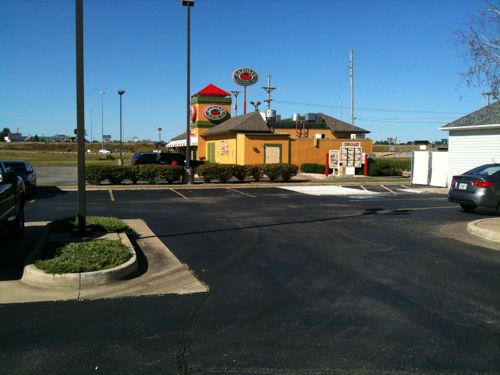Tornado Brings Opportunity To Make Joplin More Pedestrian-Friendly

As we all know, the City of Joplin was hit hard by an EF-5 tornado on May 22, 2011, making this the deadliest year on record. I know the historic & walkable downtown barely escaped the destruction. Much of Joplin, like most US cities, was a big ugly mess of auto-centric sprawl before the tornado.

I stayed a night in Joplin in September last year and posted about having to drive to the restaurant next door to the hotel to have dinner. This area wasn’t damaged so making it walkable will have to wait but the areas where every building was leveled is a perfect opportunity to make slight improvements as they rebuild.
Wikipedia has the most detailed account of the path of destruction I’ve found:
The tornado initially touched down just east of the Kansas state boundary near the end of 32nd Street (37.056958°N 94.588423°W) between 5:35 and 5:41 p.m. CDT (2235 and 2241 UTC) and tracked just north of due east. Surveys remain incomplete there so it is possible it may have started in Kansas and crossed the state line into Missouri.
Damage became very widespread and catastrophic as it entered residential subdivisions in southwest Joplin. In addition, St. John’s Regional Medical Center (37.060554°N 94.530938°W) in the same area was heavily damaged with many windows and the exterior walls damaged and the upper floors destroyed. Several fatalities were reported there. Virtually every house in that area near McClelland Boulevard and 26th Street was flattened, and some were blown away in the area as well. Trees sustained severe debarking, a nursing home and a church school in southwest Joplin were also flattened and several other schools were heavily damaged. Damage in this area was rated as a low-end EF4.
As the tornado tracked eastward, it intensified even more as it crossed Main Street between 20th and 26th Streets. Virtually every business along that stretch was heavily damaged or destroyed and several institutional buildings were destroyed. It tracked just south of downtown, narrowly missing it. More houses were flattened or blown away and trees continued to be debarked. Two large apartment buildings were destroyed, as well as Franklin Technology Center and Joplin High School. Fortunately, no one was in the high school at the time. It approached Range Line Road, the main commercial strip in the eastern part of Joplin, near 20th Street. Damage in this area was rated as a high-end EF4.
The tornado peaked in intensity as it crossed Range Line Road. In that corridor between about 13th and 32nd Streets (37.05528°N 94.478452°W), the damage continued to be very intense and the tornado was at its widest at this point, being nearly 1 mile (1.6 km) wide. Some of the many destroyed buildings include a Cummins warehouse, Walmart Supercenter #59, a Home Depot store, and numerous restaurants, all of which were flattened. Heavy objects, including concrete bumpers and large trucks, were tossed a significant distance, as far as 1/8 mile (200 m) away from the parking lots along Range Line. Numerous other commercial and industrial buildings, as well as more houses, were destroyed with some flattened or blown away as the tornado tracked through southeast Joplin. Many fatalities occurred in this area. Damage in this area was rated as an EF5.
The Red Lobster I’ve been to at 32nd & Range Line is still there, although much of that area was heavily hit. Â It has been estimated that anywhere from 10-25% of Joplin’s structures were leveled or damaged. Â Joplin now has an opportunity to rebuild in a more connected manner, to take walkability as seriously drivability.
Here are my suggestions for Joplin as they begin:
- Speed up implementation of ideas from your Long Range Transportation Plan, with particular attention to bicycle & pedestrian & public transit planning.
- Make sure every public street has a sidewalk on both sides. Do quick corridor plans for the commercial streets where damaged occurred, look for simple changes to rebuild the buildings
- Require a private sidewalk from the front door of each business to each public sidewalk, this will help create a connected sidewalk network just as roads connect places for cars. Roads provide door to door connectivity, so should the sidewalk network.
- Eliminate minimum parking requirements for businesses. This will allow businesses to spend less money on parking lots and to possibly locate their buildings closer to the public sidewalk.
- Build to the sidewalk. Â Many destroyed buildings were built up to the sidewalk and should be rebuilt that way. Neighboring buildings that had been allowed to push back from the sidewalk should be rebuilt up to the sidewalk.
My heart goes out to everyone in Joplin.
– Steve Patterson
There is precedence – Greensburg, KS (http://en.wikipedia.org/wiki/Greensburg,_Kansas) – but is there the will, in Joplin? Or, will the need to get jobs/employment back on line as quickly as possible trump “better planning”? Joplin is much bigger than Greensburg, so people are much less likely to be walking everywhere in town, but Joplin also appears to have a pretty decent little public transit system. “The Trolley system utilizes three one-hour loop routes that overlap. With the Trolley’s new routes and our recently established deviation system – the Trolley virtually covers the entire City.” (http://www.joplinmo.org/pdf/Trolley_Brochure2.pdf) The trick will be leveraging public transit, along with complete streets and sidewalks everywhere, to expand the possibilities for non-SOV travel, especially for people headed to work or school.
There is precedence – Greensburg, KS (http://en.wikipedia.org/wiki/Greensburg,_Kansas) – but is there the will, in Joplin? Or, will the need to get jobs/employment back on line as quickly as possible trump “better planning”? Joplin is much bigger than Greensburg, so people are much less likely to be walking everywhere in town, but Joplin also appears to have a pretty decent little public transit system. “The Trolley system utilizes three one-hour loop routes that overlap. With the Trolley’s new routes and our recently established deviation system – the Trolley virtually covers the entire City.” (http://www.joplinmo.org/pdf/Trolley_Brochure2.pdf) The trick will be leveraging public transit, along with complete streets and sidewalks everywhere, to expand the possibilities for non-SOV travel, especially for people headed to work or school.
Humans walk regardless of the size of town they live in. There is no expectation that someone would walk 15 miles to the other side of town! But many would walk a couple of blocks to lunch. I didn’t mention Greenburg KS because they went for green with LEED buildings, no focus on walkability to my knowledge.
Walkability IS one significant way to qualify for LEED certification. And by focusing on LEED, instead of trying to impose broader urban design reforms, is likely a quicker and more effective way to improve livability under crisis conditions like these. Plus many of the affected streets in Joplin, including the major ones, already do have sidewalks.
One of the principles of Transit Oriented Development are the 1/4 and 1/2 mile circles that define walkability around transit stops. There’s no reason why the same can’t or doesn’t apply to other, similar situations. But just putting in sidewalks does not make a place someone would actually want to walk; increasing density and providing other amenities, like trees, does. Adding more sidewalks to businesses on S. Main St. and S. Range Line, their versions of Kingshighway and Manchester Road, respectively, will do very little, alone, to encourage pedestrian use or change the big-box / strip-mall / we-all-drive paradigm of these typical suburban strips.
I also disagree with your fourth point, to eliminate minimum parking requirements, especially if there is no concurrent effort to cap the number of spaces a business would be allowed. Most businesses have minimum parking requirements of their own, rational or not, especially for new or rebuilt construction. Pizza Hut or Home Depot are NOT going to eliminate parking just because the city will let them . . .
LEED buildings do not guarantee a community will be walkable, it takes community wide planning to ensure a sidewalk network is as connected as the road network. It doesn’t just happen.
Agree, but isn’t that included in your first point, “Speed up implementation of ideas from your Long Range Transportation Plan, with particular attention to bicycle & pedestrian & public transit planning”? The fundamental challenge, here and many, many other places is simply a lack of density, driven by our preference for the SOV. One of the most god-forsaken pedestrian amenities I ever experienced was bike-ped path built along a new freeway in Colorado – there simply was no there there! People will walk short, interesting distances. As the distances increase and the parking lots take over, a sidewalk becomes about as useful as those vinyl shutters you see on houses in suburbia everywhere – all show, no real use.
Humans walk regardless of the size of town they live in. There is no expectation that someone would walk 15 miles to the other side of town! But many would walk a couple of blocks to lunch. I didn’t mention Greenburg KS because they went for green with LEED buildings, no focus on walkability to my knowledge.
Walkability IS one significant way to qualify for LEED certification. And by focusing on LEED, instead of trying to impose broader urban design reforms, is likely a quicker and more effective way to improve livability under crisis conditions like these. Plus many of the affected streets in Joplin, including the major ones, already do have sidewalks.
One of the principles of Transit Oriented Development are the 1/4 and 1/2 mile circles that define walkability around transit stops. There’s no reason why the same can’t or doesn’t apply to other, similar situations. But just putting in sidewalks does not make a place someone would actually want to walk; increasing density and providing other amenities, like trees, does. Adding more sidewalks to businesses on S. Main St. and S. Range Line, their versions of Kingshighway and Manchester Road, respectively, will do very little, alone, to encourage pedestrian use or change the big-box / strip-mall / we-all-drive paradigm of these typical suburban strips.
I also disagree with your fourth point, to eliminate minimum parking requirements, especially if there is no concurrent effort to cap the number of spaces a business would be allowed. Most businesses have minimum parking requirements of their own, rational or not, especially for new or rebuilt construction.  Pizza Hut or Home Depot are NOT going to eliminate parking just because the city will let them . . .
LEED buildings do not guarantee a community will be walkable, it takes community wide planning to ensure a sidewalk network is as connected as the road network. It doesn’t just happen.
Agree, but isn’t that included in your first point, “Speed up implementation of ideas from your Long Range Transportation Plan, with particular attention to bicycle & pedestrian & public transit planning”? The fundamental challenge, here and many, many other places is simply a lack of density, driven by our preference for the SOV. One of the most god-forsaken pedestrian amenities I ever experienced was bike-ped path built along a new freeway in Colorado – there simply was no there there! People will walk short, interesting distances. As the distances increase and the parking lots take over, a sidewalk becomes about as useful as those vinyl shutters you see on houses in suburbia everywhere – all show, no real use.